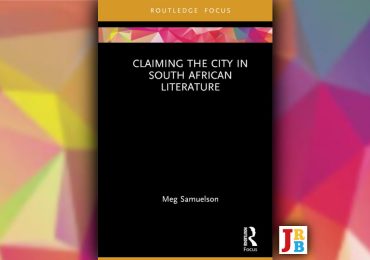Kazuo Ishiguro’s Klara and the Sun contemplates the erasure of the imagined boundary between human authenticity and the artifice of machines, writes The JRB’s Academic Editor Simon van Schalkwyk.

Klara and the Sun
Kazuo Ishiguro
Faber & Faber, 2021
Paul Virilio, the late philosopher of speed, liked to repeat Albert Einstein’s apocryphal prediction that the future of humanity depended on its ability to manage three proverbial ‘bombs’: the bomb of nuclear power, the bomb of information, and the bomb of demographics. If the successful detonation of the Manhattan Project’s atomic ‘Gadget’ announced the arrival of Einstein’s first bomb, Virilio suggested the internet and the emergence of AI identified the ‘information’ bomb. The third bomb, in Virilio’s estimation, would be linked to advances in genetics. These three bombs are at the heart of Kazuo Ishiguro’s latest novel, Klara and the Sun.
The Third Bomb: Genography
1952. A lab in Cold Spring Harbour. Alfred Hershey and Martha Chase are using a kitchen blender to shear the cells of bacteria grown in radioactive phosphorus and sulfur and infected with a T2 bacteriophage. Using the radiation to mark and track the transfer of the virus’s contents to the cell, Hershey-Chase’s ‘blender’ experiment establishes that it is not proteins but nucleic acids—Crick and Watson’s double helix of DNA and RNA—that are the source of genetic information.
If Klara, the humanoid AI that acts as Ishiguro’s narrator and focaliser, forms one strand of Klara and the Sun’s narrative helix, rapid advances in genetic engineering form the other. Designed to act as companion and confidante to children and adolescents (in the novel they are referred to as AFs; Artificial Friends), Klara is adopted by Josie, a child who has undergone genetic modification—a process referred to as ‘lifting’. Joining the ranks of an intellectual and physical elite, the ‘lifted’ find their access to the best schools and, presumably, better futures, secured by their ability to outperform those who have not undergone the treatment.
Yet there are also costs associated with the procedure. Josie is one of the unfortunate few who suffers from the debilitating and potentially mortal illness that is a by-product of genetic enhancement. Alongside a concern with how technology designed to advance intellect might have deleterious effects on the human body, Ishiguro also takes a Gattaca-like interest in ‘unlifted’ children, like Josie’s neighbour and friend Rick. What becomes of those who are not willing to risk, or who cannot afford, such enhancements, he asks, and to what lengths are they, and those who care for them, willing to go in order to secure their place in the future?
Alluding to a similar concern in his 2017 Nobel speech, Ishiguro astutely suggests that ‘new genetic technologies—such as the gene-editing tool CRISPR—and advances in Artificial Intelligence and robotics will bring us amazing, life-saving benefits’, before adding that they ‘may also create savage meritocracies that resemble apartheid, and massive unemployment, including to those in the current professional elites’.
Ishiguro offers only glancing insight into what a future divided along genetically modified lines may resemble. Mediated by the objectively studied, if naive and sometimes glitchy, perspective of Klara’s deep neural network, Ishiguro considers Rick’s cruel treatment by Josie’s ‘lifted’ friends and, later, hints at the anxieties associated with those who, like Josie’s estranged father, must securitise their homes and arm themselves against the potential dangers of living in an ‘unlifted’ part of town.
Klara offers disarmingly candid reports of these and other, related, concerns—Josie’s illness informs her mother’s distraught severity toward her daughter; genetic apartheid has forced Rick’s mother into parish-like isolation and steeled her against any guilt she may feel over the brazen lengths she is willing to go in order to secure her son’s future; and the simulated humanity of AI undergirds the chilling significance of a mysterious ‘portrait’ of Josie commissioned to a man named Capaldi.
Modulated by Klara’s discerning if frequently puzzled perspective, the unspoken tensions informing these situations are revealed with fresh intensity. Her oddly detached yet sympathetic descriptions of gesture and expression become a post-human version of literary Verfremdung, an unusually effective means by which to convey the tacit complexity of a world in which adults, for the sake of themselves as much as their children, raise troubling anxieties about the present and future, before swiftly sweeping them aside.
The Second Bomb: Oracle Machines
The summer of 1951, Princeton. After securing funding from the Air Force Office of Scientific Research, Marvin Minsky and Dean Edmonds use a gyropilot—the system used to autopilot B-52 bombers—to create a stochastic neural analogue reinforcement calculator (SNARC), arguably the world’s first neural network. Testing the model’s capacity to find its way through a maze, Minsky and Edmonds observe the movement of a signal generated by the machine via an arrangement of lights they call ‘rats’. SNARC’s ability to adjust to prior successful completions of the maze inaugurates the field of machine learning or AI.
Following a decades-long ‘AI winter’, machine-learning undertook a series of rapid and extraordinary advances, from Deep Blue’s 1997 chess victory over Garry Kasparov to the subsequent development of emotionally responsive AI robots, autonomous vehicles, chatbots, smartphones, virtual assistants like Siri and Alexa and, most recently, DeepMind’s invention of AlphaGo, the neural network that defeated seventeen-time Go world champion Lee Sedol in 2016. During the second match between AlphaGo and Sedol, the machine played what expert commentators described as ‘a very strange move’, a ‘mistake’, an inexplicable accident that they believed would surely cost the machine the game. It was only after hours of deep post-match analysis that it became clear that the move was in fact key to AlphaGo’s eventual victory.
At the moment the move was made, AlphaGo could arguably be described as what computational analysts call an oracle machine. Like this abstract entity, AlphaGo used available information—the pattern of stones arranged on the board—to produce a desired outcome, but the internal operations leading it to play the way it did remained inexplicable and opaque to even the most skilled human readers of the game.
A similar principle may be applied to Ishiguro’s Klara. For those populating the world of Ishiguro’s novel (especially Capaldi, who wishes to dismantle her in order to better understand her operating system) she is an oracle machine: a system capable of marshalling information derived from her environment in order to produce—without her interlocutors knowing exactly how or why—responses of surprising intelligence, tact, and empathetic, seemingly sympathetic, range.
To Ishiguro’s audience, however, Klara’s internal monologue reveals a great deal about her inner workings. While her observations and assessments of human interaction are sharply and sensitively weighted, the premises upon which her understanding of the world depends are frequently shown to be uncertain at best, and at worst tragically misguided. Klara’s limited capacity to absorb solar energy, for example, contributes to her eagerness to allegorise ‘the Sun’, investing it with godlike power. This belief is strengthened when, from the vantage point of the department store in which we first encounter her, she frets over the smoke emitted by a roadworks machine developed by a company called Cootings. Klara deduces that the Sun-obscuring Pollution (another entity of her allegorised inner-world) of the Cootings Machine is responsible for the seemingly terminal lethargy of a beggar and his dog, also visible from the department store window, and that the eventual reappearance of the Sun, which coincides with their revival, is responsible for their miraculous rejuvenation. This assumption is the dramatically ironic hinge upon which Klara and the Sun eventually pivots: compelled by a false premise, Klara commits herself to the similarly false logic that the destruction of the Cootings Machine, along with the rejuvenating powers of the Sun, would ensure Josie’s recovery.
Unlike Ishiguro’s Klara, many fictional projections of AI have tended to emphasise its potentially apocalyptic commitment to logical infallibility. Intelligent robots—Fritz Lang’s Maria, Alien’s Ash, The Terminator, Ava from Ex Machina and, to offer a recent literary analogy, Ian McEwan’s coldly calculating Adam—have bodied forth human anxieties about the callous ends of logical determinism. More disconcertingly, artificially intelligent organs without bodies—HAL 9000, Alien’s Mother, MCP from Tron, WOPR of WarGames, the Borg, Upgrade’s STEM, or Devs—intensify these anxieties by rendering them objectless. They are apt metaphors for dimly registered, perhaps even unimaginable, fears concerning either the supersession and subsequent disposability of human-centred understandings of minds and bodies or, more troublingly still, of the unimaginably disembodied futures already pre-empted by the virtual realm of the internet.
One would be forgiven for thinking that Ishiguro’s point is to suggest, simply and in contrast to the fictionalised norm, that the inner workings of machines may well be based not on soundly understood premises and pragmatically realised judgments but on misprision and misunderstanding. Yet Ishiguro risks a fantastical volte-face, one which appears to demand a Kierkegaardian leap of faith from the logical to the miraculous, which derails the expected course that more logical assessments of Josie’s fate might follow. Without wishing to give away too much, this turning point suggests that Ishiguro’s interests in machine learning are complemented by a more recognisable concern with magical thinking, or fiction. As Simon Schaffer explains, the term ‘magical thinking’ was introduced as a means of affirming scientific experimentation as the exclusive indicator of truth at the expense of modes of thinking and knowing that may include religious and culturally informed beliefs and knowledge systems, or miracles. Loosely defined as ‘the explanation of real phenomena by irrational causes or, rather, causes to which a certain group does not subscribe’, Shaffer astutely identifies magical thinking’s role as a boundary maintaining concept. ‘The relation that the term magical thinking established in the interwar period,’ he observes, ‘was to try and link together the way in which children, the way in which neurotics, think and the way in which people who were not European think.’
For Ishiguro, ‘magical thinking’ thus defined also informs the difference between the thought processes of AIs, like Klara, and humans. It is this difference that allows the humans in the novel to regard Klara, when they first meet her, with as much disinterest as they would ordinarily reserve for a kitchen blender. Paradoxically, however, Klara’s belief in the Sun’s ability to offer extreme solar unction seems less like a programming or algorithmic error than a peculiarly human trait, one indicative of our proclivity to cling to fictions despite the ready availability of undesirable facts. Klara is a robot who prays to the Sun in abandoned barns. Yet her sympathy and hope—the ‘expectation’ that Marvin Minsky found sorely lacking in the early days of neural networking and which he mistakenly believed would lead the field into a dead end—along with her willingness to selflessly risk actions that may do her harm, represent either the best or most naïve version of what it means to be human.
Ishiguro’s Klara suggests that deep learning neural networks will ultimately fail in their attempt to replicate human consciousness if modes of ‘magical thinking’, productive of not only error but faith in more abstract concepts such as hope, self-abnegation and the miracle, are ignored. The corollary of this, of course, is that Klara may well embody humanity’s dwindling collective nostalgia for some innocent ideal that seems to have softly and suddenly vanished away.
The First Bomb: The Dead Man’s Route
July 16, 1945. When ‘Trinity’ detonates, the sands of the desolate plains of New Mexico’s Jornada del Muerto (loosely translated as The Dead Man’s Route) are drawn into the exploding core of the nuclear cloud, where they are subjected to temperatures 1.5 times hotter than the sun. This superheated sand is transmuted into a molten glassy substance before fireballing back to earth as fallout and cooling to form Trinitite, a glassy green substance that has never before been seen on earth. Writing about the blast, Time Magazine describes the crater (tautologically and with perhaps a touch of Yellow-Peril Orientalism) as ‘lake of green jade’, noting that ‘the glass takes strange shapes—lopsided marbles, knobbly sheets a quarter-inch thick, broken, thin-walled bubbles, green, wormlike forms’.
The ensuing wave of nuclear testing—more than 2000 bombs were detonated prior to the 1996 Comprehensive Nuclear-Test-Ban Treaty—increased levels of radioactive carbon-14 to such a degree that to this day all of us carry trace-amounts of the substance in our body tissue—a techno-genetic imprint, signature, or time-stamp, marking us as children of the atom.
Less than a month after the Trinity test, B-29 bombers Enola Gay and Bockscar would deliver a twinned nuclear deathblow to Hiroshima and Nagasaki. Little Boy destroyed thirteen square kilometres of Hiroshima, the blast and ensuing firestorm instantly wiping out thirty per cent of the city’s population. Though confined to the narrow hillsides of the Urakami Valley, the bomb that struck Nagasaki is estimated to have killed 60,000 to 80,000 civilians. Including those who would later die of injuries, the death toll for these two bombs stood at over 200,000 people.
A decade after these events, and with the environmental disaster of the 1953 North Sea Flood fresh in Europe’s memory, Ishiguro’s father, Shizuo, a physical oceanographer at the forefront of electronic oceanographic modelling, relocated his family from Nagasaki to Guildford, Surrey, at the invitation of the National Institute of Oceanography. It was here that Shizuo Ishiguro developed his foundational contribution to his field: a six-foot high electronic storm surge modelling machine capable of generating electronic models of oceans to map and predict tidal patterns.
Shizuo Ishiguro took his machine home with him when he retired, storing it in his garage and tinkering with it until his death in 2007. There it mouldered until 2014, at which point it was declared an object of historical interest and installed at the Science Museum in London. In a recent interview, Kazuo Ishiguro noted that, to him, the North Sea Electronic Surge Modelling Machine had always resembled a Tardis, adding that his mother was relieved that somebody was finally going to take it away.
Klara meets her obsolescence with more equanimity. Lodged in a sort of junkyard, she comforts herself by filing through and juxtaposing a series of stored images—memories, of a kind—in a manner reminiscent of the associative logic informing Sigmund Freud’s dreamwork. Prior to this, finding herself increasingly less central to Josie’s life, Klara had begun to spend more time in an unused room in the household from which she was able to see, through an elevated casement-window, the Sun roaming across the sky and over an expansive field.
This concluding image recalls Ishiguro’s description, in his Nobel acceptance speech, of the room in which he lived while a student in the creative writing programme at the University of East Anglia. ‘[M]y little room,’ he explains, ‘was not unlike the classic writer’s garret. The ceilings sloped claustrophobically—though if I stood on tip-toes I had a view, from my one window, of ploughed fields stretching away into the distance.’ It would be imprudent to suggest that Klara is Ishiguro’s amanuensis, but if she is, Capaldi’s interest in dismantling her in order to extract information about how she operates becomes an intriguing analogy for those with a potentially lurid interest in a writer’s life or the seemingly impenetrable oracle machine of the creative imagination.
Ishiguro’s Nobel speech goes some way toward forestalling the explosion of interest that surely follows such a prize by exposing various ‘turning points’ in his career. He discusses his attempt to preserve an idea of Japan that he had to some degree invented for himself in A Pale View of Hills; how Tom Waits’s ‘Ruby’s Arms’ alerted him to what was missing in Remains of the Day; and how questions regarding the ruins at Dachau prompted a preoccupation with ‘the burdens of memory’ that forms the crux of Never Let Me Go. Only readers who are familiar with the speech would recognise Capaldi’s technologically minded interest in Klara as a moment of comic bathos in an otherwise austere novel: were he to peer inside the black box of her operating system, rather than capacitors, transistors and perceptrons, he would find a machine that runs on magic, fantasy and fiction.
Ground Zero
‘How do we recognise magical thinking?’ asks Shaffer. ‘How do you know that someone is engaging in magical thinking—you know that because they claim that what seems to us to be a boundary is in fact permeable.’ What does this mean for our understanding of the nascent technology of AI which, weirdly, strives to program machines to behave, if not to think, as humans do? What boundary becomes permeable here? And how might that boundary inform or to assert our understanding of the difference between the human and the machine, nature and technology?
Perhaps there is no boundary. As the Heideggerian philosopher Peter-Paul Verbeek explains, technology is not simply a means to an end. For Heidegger, technology should rather be understood as ‘the outcome of an understanding of the world rather than the beginning of it’. By this account, technology is an epistemological mode—a way of thinking—that paradoxically precedes the machinery that it calls into being. It is also the source of new ways of thinking about and understanding the world, an idea that has by now become standard currency. Amir Husain, the founder of SparkCognition, a company devoted to AI-based analytic and security systems, observes, ‘A lot of people think that AI is a product or technology, but it’s actually an enabler for almost everything we do.’
Rather than simply being a robot that follows her programming, as one reviewer has suggested, Klara is more than the primary function for which she has been programmed. For Josie’s mother and Capaldi, Klara is not just Josie’s minder, a technological means to a functional end. Instead, she is an effect of technological modes of thinking; a product of the same worldview that is capable of seeing in the flow of a river the potential for hydroelectric power, or in uranium the possibility of atomic energy. It is therefore better to think of Klara as an enabler for new ways of thinking and being that, as Ishiguro cannily demonstrates, trouble conventional assumptions about the difference between the human and the machine, and between machine-learning and magical thinking.
Returning to Virilio, whose pithy suggestion was that ‘the invention of the ship was also the invention of the shipwreck’, we may deduce that Klara represents a technology that contains within her the potential for a future accident: the erasure of the boundary that we imagine to exist between human authenticity and the artifice of machines, perhaps, or, more unthinkably, the accidental end of human-centred notions of intelligence itself. Ishiguro knows that Einstein’s three bombs—harbingers of the Anthropocene—have already fallen. Yet if this means that new and unforeseen accidents are waiting to happen, Klara and the Sun suggests that Ishiguro also knows that the accident that leads a machine to think magically will be a necessary miracle.
- Simon van Schalkwyk is Academic Editor and senior lecturer in the English Department at Wits University. His debut collection of poetry, Transcontinental Delay, was published in 2021.





